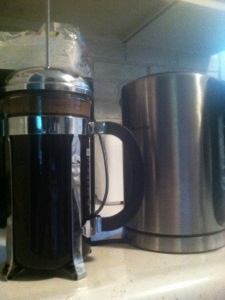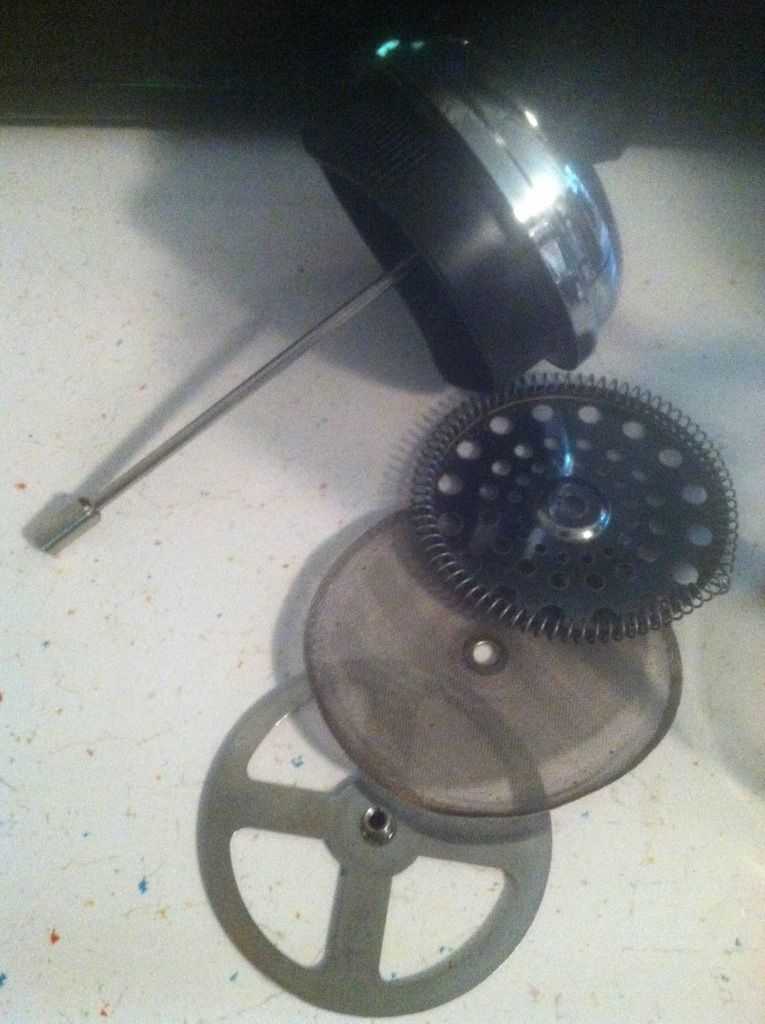Coffee is good. Can it be better? That depends on your taste, but I would recommend trying a few different ways of making it.
The most common way to make coffee (at least around here) is drip brewing, where hot water is dripped over grounds, filtered through a paper or mesh (usually brass) filter. This is a very convenient and consistent way to make coffee, but it tends to not be as strong as other brewing methods, and you lose some of the oils and other compounds that contribute to the flavor, especially with paper filters. I am going to post on several different brewing methods that I use, and maybe try a few new ones.
Making coffee with the French Press
The Tools:
The French Press is a very simple coffee maker, consisting of a container, usually a glass beaker, and a plunger mechanism with a mesh that strains out the grounds when depressed. I usually use a Bodum Chambord Coffee Press, but there are many other options, including travel mugs, and even one built into a backpacking stove.
You can use a pot or kettle on a stovetop, but I prefer an electric kettle, since it boils water quickly, and shuts off automatically once the water boils, so you don’t have to worry about leaving the stove on.
Since the French press needs a fairly coarse grind, a blade grinder will work, but a burr grinder provides a more consistent grind, and allows you to predictably adjust your grind, especially important if you use different types of coffee makers.
The Process:
Boil the water and grind the beans. I usually go right around the 2 tbsp to the 6 oz cup mark, but you can adjust to taste. When grinding for the french press go with one of the coarsest grinds available, as the finer grinds can plug up the filter mechanism, and pass through it into your coffee.
I usually use boiling water, which ends up with a slightly more bitter taste than water a little below boiling. You can boil the water, then add a little bit of cooler water to bring the temperature down to about 200 degrees.
To even better control the temperature, I warm the press up with hot tap water. Fill the press, insert and depress the plunger, and let it sit for a minute or so before making the coffee.
Once you have your water, grounds, and warmed coffee press, place the grounds in the press, then pour the water over it to a little below the top, and stir. The manufacturer instruction say not to use a metal spoon, but it hasn’t killed me yet. Just be careful not to hit the sides, as you may damage the beaker. To maintain a higher temperature, place the top on, but don’t depress the plunger. Allow the coffee to steep for 4 to 5 minutes (adjusting to taste.) When the timer is done, slowly depress the plunger. If the plunger gets clogged, you can pull it up a small amount (1/8 inch or so) do dislodge the grounds. Allow the coffee to sit for a couple minutes for any grounds in the coffee to settle before pouring.
Cleaning the French Press
To clean out the grounds, I use a rubber spatula, then rinse the beaker and plunger. It is recommended to avoid using soap on coffee making equipment because it leaves a residue that can interfere with the flavor. I just use a paper towel to remove the coffee residue, rinse the press, and dry it, or allow it to air dry.
Grounds can get stuck in the plunger, and to clean it, the plunger can be disassembled:
The elements on the bottom simply unscrew. Be careful with with the screen, the edges are folded over, but there can be sharp wires. Make sure the screen goes in right side up, so that the folded ends are to the inside. I usually loosen it up and rinse it most times that I clean it, and disassemble it once a week or so for a better cleaning.
How do you like your coffee? What is you favorite coffee maker? Leave a note in the comments.


